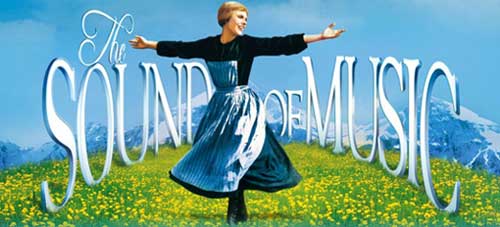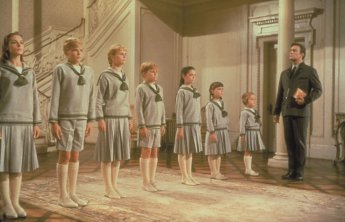
For the Week 7 “Reading Movies” assignment, I chose The Sound of Music from AFI’s 100 Years…100 Movies, a list of the 100 best American movies determined by The American Film Institute (Where is Mean Girls on the list? Kidding…). The Sound of Music was one of my favorite movies as a child, and continues to be. The movie contains wonderful music, great actors, and a rich history. There is so much more than what is shown on the screen. When I was younger, my dad and my grandmother insisted that I watch The Sound of Music. I was furious with this, as I thought it was “an old timey movie.” I wanted nothing to do with it. I would have much rather watched a cheesy pre-teen romance with Mary-Kate and Ashley, or so I thought! Needless to say, I did not get my way and was stuck watching The Sound of Music. I fell in love with the timeless storyline and the catchy tunes. When familiarizing myself with the film, after not having seen it for a few years, to this day it still encapsulates me. Time has told, Mary-Kate and Ashley movies were just a fad. The Sound of Music has proven to be a movie that stayed close to my heart. I guess my dad was right, yet again. Often times, I find myself singing to my parakeet, “The hills are alive…” You could call me Cinderella. Or how about Maria?
Though IMBD lists the genres of The Sound of Music as Biography, Drama, Family, Musical, and Romance, I have identified the film genre as Family/Musical. Not only is it a film that can be appreciated by all ages, hence the family, it’s storyline is about a rather large family! I also included Musical as a genre, because the actors often participate in the production of the music (singing, etc.). There is a lot of it, and it is not simply background music.
As far as the TV Tropes genre, I chose a few. I actually researched The Sound of Music on the TV Tropes website and they already had genres listed. I read through them and narrowed them down to the following group of four. I felt as if some were too specific.
World War II: Time period
Jerk with a Heart of Gold: Captain Von Trapp
Magical Nanny: Maria (Julie Andrews, who also assumes the same role in Mary Poppins)
Happy Ending for everyone
“One of the reasons I started teaching was to teach myself.”
In Roger Ebert‘s essay, “How to Read a Movie,” there were some points that definitely stood out to me as a future teacher, in addition to my role as a DS106 student. When Ebert talks about the class he taught in 1969, after being inspired by movie critic, John West, I noticed that he had a very democratic attitude toward education, if you will. This is something that most influenced me in the essay. No matter what age, race, gender, etc. someone is, they can be influential to you and challenge you to think. As John West recommended, I treated the clips I found from The Sound of Musicas a football coach may as he examines footage from the game. I paused the scene multiple times in order to analyze the set and positioning of the actors. I think the football analogy is a really good way to explain how people like Ebert and West analyze movies. I never knew that the way actors are positioned in scenes had so much meaning! But after this assignment, I noticed some of the points were proven true. I’ve included a few shots whose “visual compositions have intrinsic weighting,” something Ebert discusses in his essay.
“A person located somewhat to the right of center will seem ideally placed. A person to the right of that position will seem more positive; to the left, more negative…..in general terms, in a two-shot, the person on the right will ‘seem’ dominant over the person on the left.” -Roger Ebert

Captain Von Trapp is positioned to the right of his children, showing dominance.

Maria is to the left of Captain Von Trapp and the Baroness is to the right, making the Baroness seem more favorable. The Baroness on the right “seems” more dominant over the person on the left, Maria.
Ebert writes about his experience doing this exercise with his class. He says, “I wasn’t the teacher and my students weren’t the audience, we were all in this together.” Beyond the analysis of movies, this attitude towards education is very inspiring to me. Bringing people together creates a collaboration of knowledge and ideas, enabling them to learn many more things. Everyone has a different bank of knowledge, it’s important to have a variety of contributors. Like Ebert said, when pausing the movies, his students would notice a multitude of things. Anyone can state an opinion about a movie and give even critics a different perspective, something they may have not before considered. Ebert writes, ”Everything worth noticing on the screen will eventually be seen by somebody.” This applies to digital storytelling and the internet. I appreciated the humility Ebert showed when referencing Giannetti and David Bordwell. Though they may not use the same terms or have the same beliefs, he stills respects their opinions and writings; the three of them possess “the same intense curiosity,” for films, which is what really matters. In the readings we have had for DS106, I have noticed a common theme of encouraging collaboration.


Add a comment